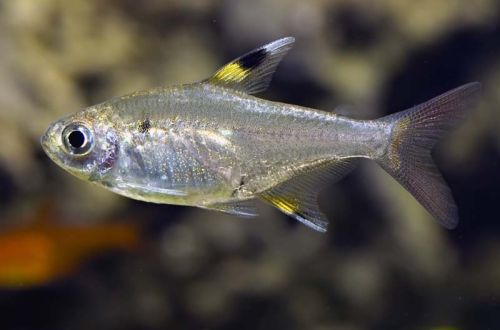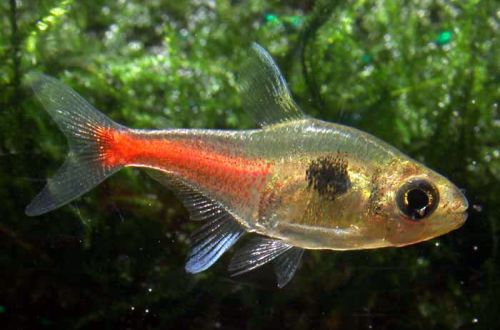
albino pristella
Albino Pristella or Transparent Albino Tetra, scientific name Pristella maxillaris, belongs to the Characidae family. It is considered one of the most popular and accessible tetras. Due to their unpretentiousness, peaceful disposition, easy breeding and low cost, they can be recommended to beginner aquarists.

Contents
Habitat
It comes from the coastal waters and river systems of Venezuela, Guyana, Suriname, French Guiana and northern Brazil. During the rainy season, it moves to the flooded areas of the river floodplain (savanna, forest canopy) for spawning. It is almost impossible to find fish caught in the wild on sale. Due to their popularity, they are commercially bred in large numbers on fish farms in Eastern Europe and the Far East.
Brief information:
- The volume of the aquarium – from 60 liters.
- Temperature – 22-28°C
- Value pH — 6.0–7.5
- Water hardness – soft to hard (2-20 dGH)
- Substrate type – any
- Lighting – subdued / moderate
- Brackish water – no
- Water Movement – Low/Moderate
- The size of the fish is up to 4.5 cm.
- Food – any food
- Temperament – peaceful, calm
- Keeping in a flock of at least 8-10 individuals
Description
Adult individuals reach a length of about 4.5 cm. The color of the body is translucent, the skeleton and some internal organs of the fish are clearly visible through the outer integument. Sexual dimorphism is weakly expressed, males are practically indistinguishable from females. It is a variation of the regular Transparent Tetra.
Food
Accepts all popular types of dry, frozen and live food. It is not demanding on the diet, so it feels great on a diet of flakes and granules. Buy food only from reputable manufacturers.
Maintenance and care, arrangement of the aquarium
Unpretentious and hardy, adapts to a variety of water conditions. There are no special requirements for design, and it depends only on the imagination and financial capabilities of the aquarist, or on the needs of other aquarium neighbors.
As far as keeping albino Pristella is concerned, it successfully adapts to a fairly wide range of pH and dGH values, however, there are limitations to the arrangement of the aquarium – it is necessary to provide subdued light and use a dark substrate.
Aquarium maintenance comes down to regular cleaning of the soil from organic waste (uneaten food residues, excrement) and weekly water changes (15–20% of the volume) with fresh water.
Behavior and Compatibility
Peaceful schooling calm fish, content in a group of at least 6-10 individuals. They do not react well to noisy overly active neighbors, they are perfectly compatible with other South American species, for example, small tetras and catfish, Pecilobricon, Hatchetfish, as well as rasboras and viviparous species.
Breeding / breeding
The appearance of fry is possible even in a common aquarium, but their number will be very small and will decrease every day if they are not transplanted into a separate tank in time. In order to increase the chances of survival and somehow systematize the breeding process (spawning was not spontaneous), it is recommended to use a spawning aquarium, where adult fish are placed during the mating season.
Usually this is a small container with a volume of about 20 liters. The design is arbitrary, the main emphasis is on the substrate. In order to protect the eggs from being eaten, the bottom is covered with a fine-mesh net, or with small-leaved plants or mosses (for example, Java moss). An alternative way is to place a layer of glass beads with a diameter of at least 1 cm. The lighting is subdued, a heater and a simple airlift filter are sufficient from the equipment.
The stimulus for the beginning of the mating season is a gradual change in the water parameters in the common aquarium to the following values: pH 5.5–6.5, dH 2–8 at a temperature of about 26–28°C. The basis of the diet should be frozen or live food.
Carefully observe the fish, soon some of them will become noticeably rounded – these are females swollen from caviar. Prepare and fill the spawning tank with water from the community tank. Put the females there, the next day a couple of large males that look the most striking.
It remains to wait until spawning occurs, its end can be determined by females, they will “lose weight” greatly, and eggs will be noticeable among the vegetation (under a fine mesh).
The fish are returned. The fry will appear within 24-48 hours, after another 3-4 days they will begin to swim freely in search of food. Feed with specialized microfeed.
Fish diseases
A balanced aquarium biosystem with suitable conditions is the best guarantee against the occurrence of any diseases, therefore, if the fish has changed behavior, color, unusual spots and other symptoms appear, first check the water parameters, and only then proceed to treatment.





